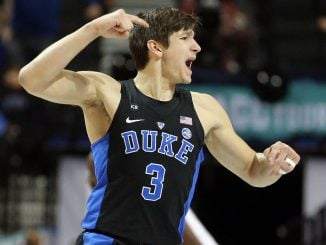
WINSTON-SALEM — Kyle Filipowski remembered seeing the images of Iowa women’s basketball star Caitlin Clark being accidentally knocked down by a fan storming the court after her team suffered an upset loss.
Roughly a month later, Duke’s 7-foot star found himself part of the same discussion on the dangers of court- storming, his right leg wrapped in plastic to fasten an icebag to his kneecap. And he wasn’t happy about what had just happened.
“Just like any other upset game where the fans rush the court, all hell goes crazy,” Filipowski said after hurting his knee in a collision with an on-rushing fan after the eighth-ranked Blue Devils lost 83-79 at Wake Forest on Saturday. “Just trying to get my way off the court, and you know, you’ve got these crazy college students just doing whatever they want. It’s got to be a little more protective when things like that happen.”
The Clark incident, coming Jan. 21 after then-No. 2 Iowa’s loss at Ohio State, offered a reminder of the risk facing athletes and coaching staffs stuck in the path of an oncoming exuberant rush of fans eager to celebrate at midcourt.
It’s long been regarded as a right of passage and part of the fabric of college athletics, most notably in a sport that captures the national spotlight every year with its “March Madness” spectacle in the NCAA Tournament. Yet Saturday marked the latest incident of the potentially combustible combination created by fans venturing between the lines that belong to the athletes right up to that final horn — this time involving an Associated Press preseason All-American.
Duke coach Jon Scheyer was ready to press that point the moment he sat down at the table for his postgame news conference.
“When are we going to ban court-storming?” Scheyer said. “Like, when are we going to ban that? How many times does a player have to get into something where they get punched or they get pushed or they get taunted right in their face? It’s a dangerous thing.”
The prologue came with Duke trailing by four with 1.8 seconds left, down to a single inbounds heave for some type of miracle finish. Fans had already moved down to the court area as Mark Mitchell heaved a long inbounds pass that was intercepted by Cam Hildreth near midcourt. And they were at full sprint once the horn sounded.
“I mean, like everyone knew it was coming,” Filipowski said. “They were up four with 2 seconds left. Everyone was just waiting for the moment. Did they do anything to stop it? They didn’t do anything to stop it. That’s just ridiculous.”
Filipowski’s collision happened as he walked from one sideline to the other toward the Duke bench, putting him in the path of what amounted to a wide oncoming rush from the baseline.
Filipowski, who had raised his arms as though to brace for a potential collision, appeared to bang his right leg into the leg of a fan running by him and spun off balance. He ended up wrapping his arms around the shoulders of a manager and walk-on teammate Stanley Borden for help getting through the locker-room tunnel amid the chaos.
Footage showed one Wake Forest fan shoving his right hand into the middle of the No. 30 on the back of Filipowski’s jersey as he wobbled.
“I’ve already heard that there’s some videos of getting punched in the back, so I absolutely feel like it was personal,” Filipowski said. “You know, intentional for sure. Like I said, there’s no reason where they see a big guy like me trying to work my way off the court and they can’t just work around me. There’s no excuse for that.”
Scheyer — who referenced the Clark incident and said he regretted not pulling his players off the court sooner — was asked whether he would press the issue with Atlantic Coast Conference officials for changes going forward.
“Yeah, they’re here today, you see it,” Scheyer said. “Who in their right mind can see that and (say), ‘Yeah, that’s smart’? It’s dangerous. In what other sport does that happen? And I’m telling you, I don’t even think, it was — what, did the buzzer go off and all of a sudden fans are at halfcourt.”
It certainly happened fast on a day when the vibe in Joel Coliseum befitted the stakes for the Demon Deacons, who drew a record crowd and their first sellout since 2017 while trying to earn a major boost to their chances of earning an NCAA Tournament bid.
By game’s end, though, the Filipowski incident had put a damper on the afterglow of what had been a rousing performance.
“I didn’t see what happened at the end, I hope he’s OK,” Wake Forest coach Steve Forbes said. “I don’t like court-stormings, I never have. I’ve been a part of those before as a coach. They just don’t feel safe. And I’m sure the next time that happens, we’ll do a better job of taking care of that situation.”



